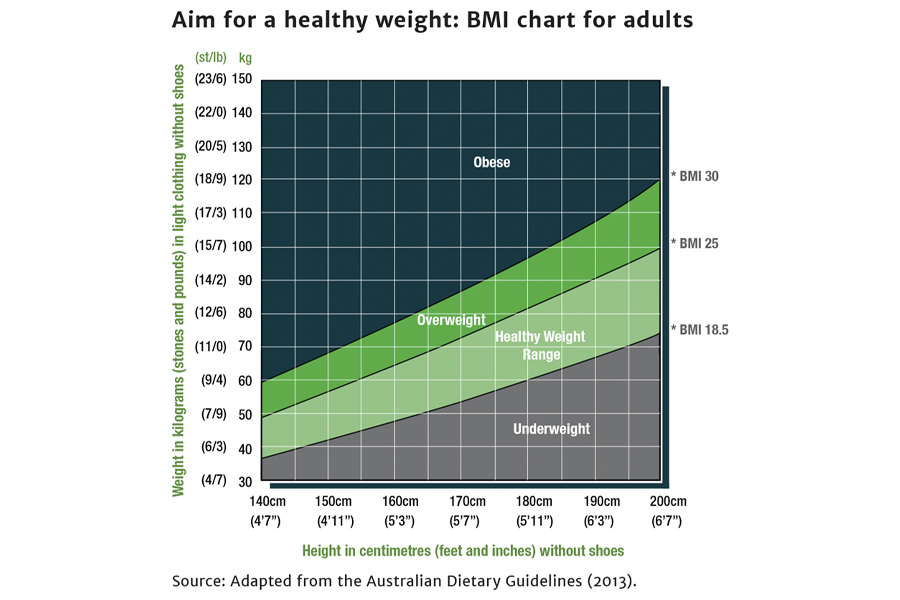
Published:
Readtime: 7 min
Every product is carefully selected by our editors and experts. If you buy from a link, we may earn a commission. Learn more. For more information on how we test products, click here.
Below is a simple BMI calculator to determine your Body Mass Index. To use the BMI calculator:
- Input your height and weight
- The BMI calculator will decipher the information and summarise it in a numerical value.
- From here, you will be able to categorise yourself into an underweight, normal, overweight or obese category.
BMI Calculator
REMEMBER! It's important to note that BMI is only a rough estimation and results can be somewhat misleading for certain individuals such as well-muscled individuals like bodybuilders. Remember, take the results with a grain of sand.
BMI Chart
In order to help you make sense of the equation and results, here is a chart, as based on the Australian Dietary Guidelines 2013.

How to Calculate Your BMI Properly
If you've ever found yourself on the road to weight loss, chances are you've stumbled across the BMI calculator. Generally, one of the first things you'll do when you kick-start a new diet plan or fitness regime is to measure your current physique. While staring in the mirror and judging yourself on the 'am I fat?' scale is one way to do it, the eye test simply isn't as efficient as some of our other options. While it's useful in formulating a better understanding of your genetic and physical make-up, the answer to the question 'What is my BMI?' can tell you a lot more than just whether you need to lose weight or not.
You'll also like:
How Many Calories Per Day to Lose Weight?
Top 10 Foods to Burn Calories
10 Best Weight Loss Exercises for the Ultimate Shred

What is BMI?
Your Body Mass Index, as it is formally known is a unit of measurement that is derived from the mass and height of a person. In previous generations, the BMI was used to decipher if someone was in a healthy weight range, personalised to their specific measurements. It originated in a 1972 edition of the Journal of Chronic Diseases by Ancel Keys and others, following increased obesity in prosperous Western societies.
Put simply, BMI provides a simple numeric measure of a person's thickness or thinness, opening the discussion between health professionals regarding weight problems more objectively with their patients. Designed to be used as a simple means of classifying average sedentary (physically inactive) populations, the BMI is a measure of average body composition. The BMI is universally expressed in kg/m2, resulting from mass in kilograms and height in metres, however, it's fairly common to give your BMI as a numerical value with no units.
In the years that have passed, the BMI formula has been partially debunked as a critical and essential method for health-related information, however, it stills serves a valuable purpose. While not 100 per cent indicative of someone's health, your BMI will provide you with a basic understanding of your current fat: muscle: bone density, which can play an important inaugural role in setting up your fitness or workout regime. From a basic perspective, the BMI calculator is used to categorise someone as underweight, normal weight, overweight or obese, based on tissue mass (muscle, fat and bone).

Who Shouldn't Use a BMI Calculator
While the BMI can be helpful in determining a person's thinness or thickness, it isn't a complete tool. In fact, medical professionals have widely noted that the BMI calculator is not an accurate way to measure a human being's body composition. Certain lifestyle, genetic and hereditary factors can influence your metabolic and physically composition, which may throw out the general BMI calculations. Lean male athletes, for instance, often have a high muscle-to-fat ratio and therefore a BMI that is misleadingly high relative to their body-fat percentage.
Like all generalised tools and measurement guides, the BMI calculator should be taken as a simple starting point. It won't provide you with enough information to drastically shift your life, provided you aren't already visibly over or underweight, but it may help to solidify any concerns or questions you may have.
Further to that, health researchers have found that while the BMI might not be an accurate individual measurement, it has some merit in the classification of groups. For example, researchers have shown that a group of people with BMIs of 30, is more likely to have a serious illness and die younger, on average, than a group of people with BMIs of 20. Similarly, some basic results indicate that the healthy BMI range tends to be lower for people of Asian descent, and higher for those of Polynesian descent.

How to Calculate Your Body Mass Index
To work out your body mass index, it's always advised to use a BMI calculator, however, understanding the principles of the formula is helpful. The general equation takes into account your weight and height, spitting out a final numerical value that will fall into one of the four aforementioned categories. The BMI formula is as follows;
Body Mass Index = Weight (kg)/Height (m)2
What is the Ideal BMI?
As we mentioned, the BMI calculator is used to categorise people into one of four sections. Here are the basic protocols and requirements for each category.
| Weight | BMI Score |
| Underweight | < 18.5 |
| Normal Weight | 18.5 - 24.9 |
| Overweight | 25 - 29.9 |
| Obese | > 30 |
- Underweight - If your BMI is less than 18.5, your BMI is within the underweight category, which may cause complications with your health. It is advised that you visit a doctor to discuss options that will address this.
- Normal weight - If your BMI is between 18.5 and 24.9, your BMI is within the healthy weight category. This is the sweet spot for your health, but therein lies the challenge to maintain that weight, and not add excessive kilos as you get older.
- Overweight - If your BMI is between 25 and 29.9, your BMI is within the overweight category and should be addressed. Some basic exercise and lifestyle choices will enable you to better approach health and fitness, meaning you will feel more active.
- Obese - If your BMI is 30 or over, you are within the obese category. It is critically important that you visit a doctor and work on developing a plan to tackle your weight. Staying at an obese weight range for an extended period of time can cause irreparable damage to your body.
For this reason, it's suggested that you maintain a BMI range of between 18-5 and 24, ensuring that you have a mix of high-value muscle fibres and fat. That being said, some lifestyle and genetic factors may plan into this, so if you are unsure, it's always advised to visit your doctor.
You'll also like:
How Many Calories Per Day to Lose Weight?
Top 10 Foods to Burn Calories
10 Best Weight Loss Exercises for the Ultimate Shred
General FAQs
Your Body Mass Index (BMI) can be calculated using your height and weight, The basic formula is BMI = kg/m2 where kg is a person's weight in kilograms and m2 is their height in metres squared. A BMI of 25.0 or more is overweight, while the healthy range is 18.5 to 24.9.
According to basic and generalised approaches, a BMI of 25.0 or more is overweight, while the healthy range is 18.5 to 24.9.
Most medical professionals will tell you that a healthy BMI range is 18.5 to 24.9, however, certain lifestyle, medical and hereditary factors may play into this.































Comments
We love hearing from you. or to leave a comment.